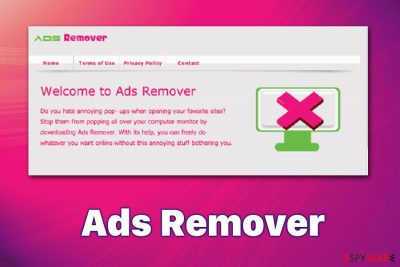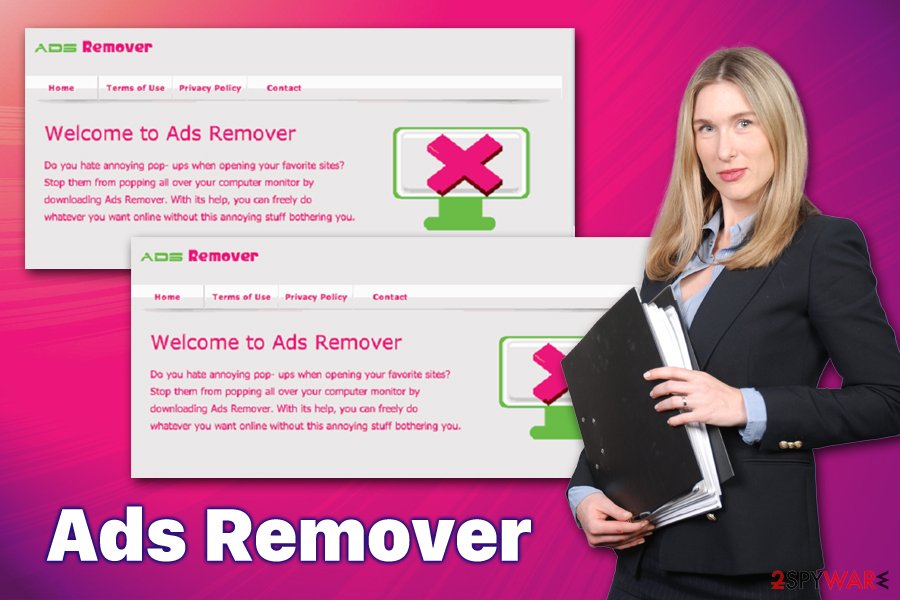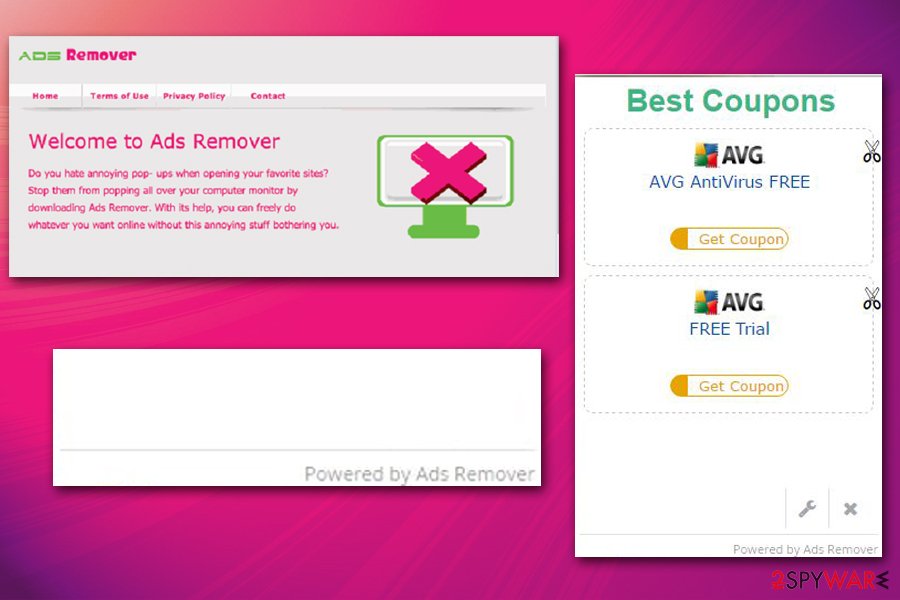Ads Remover (Virus Removal Instructions) - Jan 2020 update
Ads Remover Removal Guide
What is Ads Remover?
Ads Remover – potentially unwanted program that performs actions it claims to remove

Ads Remover is an adware[1] program, which can be downloaded from its official website, although many people find it installed as an extension on their Google Chrome, Mozilla Firefox, or Safari unexpectedly. The latter happens due to the careless installation of freeware (downloaded from third-party websites) that are packaged with optional apps.
Ads Remover claims to get rid of one of the most annoying aspects of internet browsing – pop-ups, in-text links, advertisement banners, and many other ads that plague the web. As a general rule, ad-blockers are also excellent additions to all the computers due to their ability to block malicious, JavaScript-based ads[2] that abuse browser vulnerabilities in order to install malware without user interaction.
Unfortunately, those that decide to keep Ads Remover will get more than they bargained for, as they will soon notice that their browsers are suffering from hijacking symptoms, and intrusive content from various sites is replaced a virtual layer of ads marked by “Ads by Ads Remover” or “Ads Remove Ads.” Ironically, the extension that is supposed to be helping you to fight ads brings them in itself.
| Name | Ads Remover |
| Type | Potentially unwanted program, adware |
| Other names | PUP.Optional.Ads Remover.A |
| Related process | The affected users may find adsremover.exe running in the background (Task Manager) |
| Infiltration | Users might download the unwanted app via the official website, or get it installed without proper permission via software bundles |
| Symptoms | Inserts ads on all visited websites, redirects to suspicious websites, inserts sponsored links into search results, slows down the browser, runs a background process |
| Risks | Installation of other potentially unwanted programs or malware, sensitive data disclosure to unknown parties, money loss, etc. |
| Termination | Uninstall Ads Remover as per instructions below manually or employ anti-virus that is capable of detecting PUPs |
| Recovery | After you get rid of adware and malware, you might experience system crashes, slowdowns, and other after-effects of the infection. In that case, we recommend using PC repair tool FortectIntego |
No users like to deal with intrusive ads – pop up on the full screen, start playing unwanted sounds/videos, hinder the content of the website, etc. On the other hand, most do not care about small ads inserted on sites, as they do not interfere with user browsing experience and also let website publishers monetize and fund their activities, as well as provide new content. Unfortunately, some apps are created in order to monetize only, and user experience does not matter for the developers. Ads Remover is one of such programs.
Ads Remover virus is not the only app that claims to benefit users but does the complete opposite. For example, rogue-anti-spyware programs[3] often modify Windows system files to imitate malicious activity to make users believe that their computers are infected and need fixing. In reality, all it wants is to steal users' credit card details or make them purchase the paid version of the useless app.

Reasons for Ads Remover being categorized as a potentially unwanted program and adware are as follows:
- Usually arrives to the system via software bundle packages
- Displays commercial content on all sites that your visit
- Redirects to to sites that might distribute other PUPs or show scam messages
- Slows down the web browser and computer due to background processes and ad generation process
- Disguises as a useful program but does not fulfill its purpose as advertised.
Ads Remover developers claim the following:
Welcome to Ads Remover
Do you hate annoying pop-ups when opening your favorite sites? Stop them from poping over your computer monitor by downloading Ads Remover. With its help, you can freely do whatever you want online without this annoying stuff bothering you.
However, as it becomes apparent to most users quickly, the installed app starts displaying its ads (“Ads by Ads Remover,” “Powered by Ads Remover,” “Brought by Ads Remover,” etc.). Although they might seem like ordinary commercial offers, keep in mind that they are powered by third-parties and might be much more annoying and than ads from the visited websites.
Even more, Ads Remover ads may cause redirects to questionable third-party domains visiting, which is potentially risky since you might catch another computer infection. In addition to that, the app may also place tracking cookies, use your computer resources by running several processes continuously, thereby slowing it down, cause browser crashes, and similar inconveniences. We highly recommend you remove Ads Remover from your system and instead use tools that actually do what they promise – Ublock, Adblock, and others.
Note: you can find full Ads Remover removal instructions below – you can either terminate adware manually or by employing anti-malware software that can recognize PUPs. Additionally, experts[4] also recommend resetting all the installed browsers and scanning the machine with FortectIntego for the best results.
Installation routine and prevention methods
Ads Remover redirects may start bothering you once you install the add-on, which might be done by accessing its official or downloading another software with a bundle. Of course, after reading this article, you will probably have no intention of installing it manually.
However, in order to prevent stealthy Ads Remover infiltration, you have to be very careful with free downloads. This add-on is commonly attached to various download managers or media players as an “additional component,” which can be noticed only when checking Advanced/Custom settings.
So make sure that instead of Quick or Basic installation settings, you select to check Advanced settings and carefully monitor the entire process step-by-step. If you notice a notification saying that you agree to install Ads Remover add-on, make sure that the tick alongside it is unchecked.

Get rid of Ads Remover and choose alternatives that do what they are designed to – block ads
Ads Remover removal should not be a complicated task, as it should be easily terminated via the Add/Remove programs section in the Control Panel. However, don't forget that you also might have a browser extension installed that might be the cause of persistent ads even after the main applications in terminated. Therefore, you can check the instructions below and reset all the installed browsers for best results.
Note that you can also remove Ads Remover automatically by performing a full system scan with anti-malware software capable of detecting and removing potentially unwanted programs. Besides, this method will also ensure that all the other unwanted programs and malware are taken care of.
You may remove virus damage with a help of FortectIntego. SpyHunter 5Combo Cleaner and Malwarebytes are recommended to detect potentially unwanted programs and viruses with all their files and registry entries that are related to them.
Getting rid of Ads Remover. Follow these steps
Uninstall from Windows
To get rid of Ads Remover ads, uninstall the application via Control Panel:
Instructions for Windows 10/8 machines:
- Enter Control Panel into Windows search box and hit Enter or click on the search result.
- Under Programs, select Uninstall a program.

- From the list, find the entry of the suspicious program.
- Right-click on the application and select Uninstall.
- If User Account Control shows up, click Yes.
- Wait till uninstallation process is complete and click OK.

If you are Windows 7/XP user, proceed with the following instructions:
- Click on Windows Start > Control Panel located on the right pane (if you are Windows XP user, click on Add/Remove Programs).
- In Control Panel, select Programs > Uninstall a program.

- Pick the unwanted application by clicking on it once.
- At the top, click Uninstall/Change.
- In the confirmation prompt, pick Yes.
- Click OK once the removal process is finished.
Delete from macOS
If your macOS is suffering from unending ads, perform the following actions:
Remove items from Applications folder:
- From the menu bar, select Go > Applications.
- In the Applications folder, look for all related entries.
- Click on the app and drag it to Trash (or right-click and pick Move to Trash)

To fully remove an unwanted app, you need to access Application Support, LaunchAgents, and LaunchDaemons folders and delete relevant files:
- Select Go > Go to Folder.
- Enter /Library/Application Support and click Go or press Enter.
- In the Application Support folder, look for any dubious entries and then delete them.
- Now enter /Library/LaunchAgents and /Library/LaunchDaemons folders the same way and terminate all the related .plist files.

Remove from Microsoft Edge
Delete unwanted extensions from MS Edge:
- Select Menu (three horizontal dots at the top-right of the browser window) and pick Extensions.
- From the list, pick the extension and click on the Gear icon.
- Click on Uninstall at the bottom.

Clear cookies and other browser data:
- Click on the Menu (three horizontal dots at the top-right of the browser window) and select Privacy & security.
- Under Clear browsing data, pick Choose what to clear.
- Select everything (apart from passwords, although you might want to include Media licenses as well, if applicable) and click on Clear.

Restore new tab and homepage settings:
- Click the menu icon and choose Settings.
- Then find On startup section.
- Click Disable if you found any suspicious domain.
Reset MS Edge if the above steps did not work:
- Press on Ctrl + Shift + Esc to open Task Manager.
- Click on More details arrow at the bottom of the window.
- Select Details tab.
- Now scroll down and locate every entry with Microsoft Edge name in it. Right-click on each of them and select End Task to stop MS Edge from running.

If this solution failed to help you, you need to use an advanced Edge reset method. Note that you need to backup your data before proceeding.
- Find the following folder on your computer: C:\\Users\\%username%\\AppData\\Local\\Packages\\Microsoft.MicrosoftEdge_8wekyb3d8bbwe.
- Press Ctrl + A on your keyboard to select all folders.
- Right-click on them and pick Delete

- Now right-click on the Start button and pick Windows PowerShell (Admin).
- When the new window opens, copy and paste the following command, and then press Enter:
Get-AppXPackage -AllUsers -Name Microsoft.MicrosoftEdge | Foreach {Add-AppxPackage -DisableDevelopmentMode -Register “$($_.InstallLocation)\\AppXManifest.xml” -Verbose

Instructions for Chromium-based Edge
Delete extensions from MS Edge (Chromium):
- Open Edge and click select Settings > Extensions.
- Delete unwanted extensions by clicking Remove.

Clear cache and site data:
- Click on Menu and go to Settings.
- Select Privacy, search and services.
- Under Clear browsing data, pick Choose what to clear.
- Under Time range, pick All time.
- Select Clear now.

Reset Chromium-based MS Edge:
- Click on Menu and select Settings.
- On the left side, pick Reset settings.
- Select Restore settings to their default values.
- Confirm with Reset.

Remove from Mozilla Firefox (FF)
Reset Mozilla Firefox to get rid of settings that were changed when PUP was installed.
Remove dangerous extensions:
- Open Mozilla Firefox browser and click on the Menu (three horizontal lines at the top-right of the window).
- Select Add-ons.
- In here, select unwanted plugin and click Remove.

Reset the homepage:
- Click three horizontal lines at the top right corner to open the menu.
- Choose Options.
- Under Home options, enter your preferred site that will open every time you newly open the Mozilla Firefox.
Clear cookies and site data:
- Click Menu and pick Settings.
- Go to Privacy & Security section.
- Scroll down to locate Cookies and Site Data.
- Click on Clear Data…
- Select Cookies and Site Data, as well as Cached Web Content and press Clear.

Reset Mozilla Firefox
If clearing the browser as explained above did not help, reset Mozilla Firefox:
- Open Mozilla Firefox browser and click the Menu.
- Go to Help and then choose Troubleshooting Information.

- Under Give Firefox a tune up section, click on Refresh Firefox…
- Once the pop-up shows up, confirm the action by pressing on Refresh Firefox.

Remove from Google Chrome
Delete malicious extensions from Google Chrome:
- Open Google Chrome, click on the Menu (three vertical dots at the top-right corner) and select More tools > Extensions.
- In the newly opened window, you will see all the installed extensions. Uninstall all the suspicious plugins that might be related to the unwanted program by clicking Remove.

Clear cache and web data from Chrome:
- Click on Menu and pick Settings.
- Under Privacy and security, select Clear browsing data.
- Select Browsing history, Cookies and other site data, as well as Cached images and files.
- Click Clear data.

Change your homepage:
- Click menu and choose Settings.
- Look for a suspicious site in the On startup section.
- Click on Open a specific or set of pages and click on three dots to find the Remove option.
Reset Google Chrome:
If the previous methods did not help you, reset Google Chrome to eliminate all the unwanted components:
- Click on Menu and select Settings.
- In the Settings, scroll down and click Advanced.
- Scroll down and locate Reset and clean up section.
- Now click Restore settings to their original defaults.
- Confirm with Reset settings.

Delete from Safari
Remove unwanted extensions from Safari:
- Click Safari > Preferences…
- In the new window, pick Extensions.
- Select the unwanted extension and select Uninstall.

Clear cookies and other website data from Safari:
- Click Safari > Clear History…
- From the drop-down menu under Clear, pick all history.
- Confirm with Clear History.

Reset Safari if the above-mentioned steps did not help you:
- Click Safari > Preferences…
- Go to Advanced tab.
- Tick the Show Develop menu in menu bar.
- From the menu bar, click Develop, and then select Empty Caches.

After uninstalling this potentially unwanted program (PUP) and fixing each of your web browsers, we recommend you to scan your PC system with a reputable anti-spyware. This will help you to get rid of Ads Remover registry traces and will also identify related parasites or possible malware infections on your computer. For that you can use our top-rated malware remover: FortectIntego, SpyHunter 5Combo Cleaner or Malwarebytes.
How to prevent from getting adware
Protect your privacy – employ a VPN
There are several ways how to make your online time more private – you can access an incognito tab. However, there is no secret that even in this mode, you are tracked for advertising purposes. There is a way to add an extra layer of protection and create a completely anonymous web browsing practice with the help of Private Internet Access VPN. This software reroutes traffic through different servers, thus leaving your IP address and geolocation in disguise. Besides, it is based on a strict no-log policy, meaning that no data will be recorded, leaked, and available for both first and third parties. The combination of a secure web browser and Private Internet Access VPN will let you browse the Internet without a feeling of being spied or targeted by criminals.
No backups? No problem. Use a data recovery tool
If you wonder how data loss can occur, you should not look any further for answers – human errors, malware attacks, hardware failures, power cuts, natural disasters, or even simple negligence. In some cases, lost files are extremely important, and many straight out panic when such an unfortunate course of events happen. Due to this, you should always ensure that you prepare proper data backups on a regular basis.
If you were caught by surprise and did not have any backups to restore your files from, not everything is lost. Data Recovery Pro is one of the leading file recovery solutions you can find on the market – it is likely to restore even lost emails or data located on an external device.
- ^ Ellen Zhang. What is adware? How it works and how to protect yourself against adware. Digital Guardian. Enterprise IP & DLP Software.
- ^ Steven Melendez. A New Wave Of Bad Ads Is Hijacking Even Top-Tier Websites. Fast Company. The future of business.
- ^ Rogue security software. Wikipedia. The free encyclopedia.
- ^ Bedynet. Bedynet. Security advice.























